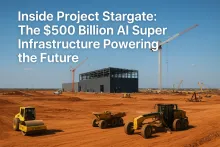
A radical build. Gigawatts of power. Hundreds of thousands of GPUs. Project Stargate aims to change how AI is made, hosted, and scaled.
What is Project Stargate?
Project Stargate is an ambitious cluster of AI-optimized data centers whose initial site—dubbed Project Ludicrous—is under construction on a 1,200-acre campus near Abilene, Texas. The plan: eight enormous buildings, each holding tens of thousands of high-performance GPUs (Nvidia Blackwell and successors) that together would create one of the world’s largest known compute clusters.
Backed by major industry players—OpenAI, SoftBank and Oracle—Stargate represents both a technical and financial leap: partners have so far committed roughly $100 billion to this project and articulated a willingness to scale investments significantly as the build extends to multiple sites.
The engineering and scale
The project’s scale is extraordinary: Crusoe (the operations lead) expects each building to host up to 50,000 GPUs with a campus capacity target above 1.2 gigawatts of electrical load. For perspective, 1.2 GW of capacity is comparable to powering hundreds of thousands of homes and is often cited in the project brief as the baseline power footprint for the initial campus.
“This is the biggest infrastructure project in history,” said one project leader—framing Stargate alongside nation-scale public works like the US interstate system.
Why Abilene, Texas?
Stargate’s choice of West Texas is pragmatic: abundant low-cost wind energy, open land and a region already building power infrastructure. The area’s energy profile—large wind farms paired with under-utilised capacity—makes it an attractive location for AI workloads that require both large, steady power and low energy cost.
Energy, cooling and sustainability challenges
Modern AI compute is power-hungry. Where data center racks used to be budgeted for ~2–4 kW, cutting-edge GPU racks now run on the order of 100+ kW per rack. That creates three systemic challenges: electricity capacity, cooling, and sustainability.
Crusoe asserts they use closed-loop water cooling for the GPU halls—filling the system once rather than consuming millions of gallons continually. Still, analysts warn the rapid buildout of AI data centers could meaningfully increase grid demand; some projections estimate data centers may consume a rising share of national electricity by the mid-2030s.
The AI arms race
Stargate is part of a broader global buildout. Microsoft, Google, Amazon, Meta and xAI are all investing heavily in compute campuses. Each player wants capacity to train larger models, serve more users, and compete toward the long-term goal of AGI—Artificial General Intelligence.
OpenAI’s leadership argues that user demand after ChatGPT's release made clear the need for massive scaling—both for training new models and for handling inference (real-time user queries) at scale.
Business case, risk and skepticism
There are significant financial and technical risks. Building and powering mega clusters is expensive—the supply chain (chips, power infrastructure, specialized cooling) is complex—and companies can absorb heavy losses while pursuing growth. OpenAI reported large losses in 2024, underscoring the capital intensity of this era.
Critics point to work like DeepSeek—models claiming similar performance at much lower compute cost—to argue that raw scale might not always be necessary. Proponents counter that increased usage and cheaper models will still drive overall demand higher, meaning more compute will remain necessary.
Local impact: jobs, taxes and tradeoffs
For Abilene, Stargate promises jobs, investment, and an expanded tax base—albeit with notable concessions: local municipalities frequently incentivize large data center builds through tax abatements and infrastructure deals. That tradeoff raises debate about long-term community benefits versus short-term concessions.
Even beyond municipal economics, there’s a social and workforce story: regions reliant on single industries (e.g., oil and gas) could see new employment options—but the number of permanent data-center roles is often lower than the construction-phase peak employment numbers suggest.
The geopolitical and supply-chain picture
Stargate also exists in a shifting geopolitics environment. Tariffs, trade frictions and the global nature of chip manufacturing (Taiwan, Korea, Japan, China) make supply chain resilience a major strategic concern. Some leaders argue for more manufacturing and packaging closer to where compute is used, driven in part by policies like the CHIPS Act.
What happens next?
If Stargate delivers at scale, the effects could be transformative—accelerating AI-driven discovery in science, medicine, materials, and engineering. If demand falters or compute efficiency leaps far beyond expectations, the project could be criticized for overbuilding.
The likely reality is a mixed outcome: periods of explosive growth, punctuated by optimization and market corrections. Still, the sustained investment suggests many stakeholders see a long runway for AI infrastructure—and they’re racing to secure it.
Bottom line
Project Stargate is a bold bet on the future of AI. It bundles immense compute, energy demand, local economic promises, and geopolitical implications into a single, massive project. Whether it becomes the backbone of an AI-enabled future or a cautionary tale of overinvestment will depend on technology improvements, market adoption, and how society chooses to power and regulate the compute engines of tomorrow.
